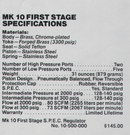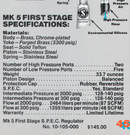One of my mentors for reg servicing preferred diving with Apeks regs over Scubapro for one, the Mk25 was noisy.
You are using an out of date browser. It may not display this or other websites correctly.
You should upgrade or use an alternative browser.
You should upgrade or use an alternative browser.
Which Scubapro piston 1st stage is the overall best?
- Thread starter Eric Sedletzky
- Start date
Please register or login
Welcome to ScubaBoard, the world's largest scuba diving community. Registration is not required to read the forums, but we encourage you to join. Joining has its benefits and enables you to participate in the discussions.
Benefits of registering include
- Ability to post and comment on topics and discussions.
- A Free photo gallery to share your dive photos with the world.
- You can make this box go away
OP
Eric Sedletzky
Contributor
My MK20 used to whistle back in the day after I had it serviced. After another service a time later it quit. I have never personally serviced my MK20 because of difficulty of obtaining parts and I also had many other regs I’ve been using so it has been sitting. It has always been serviced by a shop.
I think it was @halocline that talked about whistling piston first stages and how he cured the problem by using a bit higher duro O-ring on the piston and got it to stop.
I think it was @halocline that talked about whistling piston first stages and how he cured the problem by using a bit higher duro O-ring on the piston and got it to stop.
But have you EVER seen such a regal name for pipe dope?
View attachment 663564
"Chesterton 900 GoldEnd Paste"
It just rolls off the tongue, doesn't it?
Oh, wait! You talkin' bout @lexvil ?
Yep, Scubapro or as they spell it in the Dealer News, "SCUBPARO" promotes a Chesterton I'm familiar with. Certainly not G.K. anyway.
As for the real Pipe Dope, I he is resting in peace. Yet another good guy I miss from SB:
pipedope
I recently bought this mk10 with a BA in japan (for about 120 dollars?). So this is a Mk10 with the SPEC holes but no boot installed right?
Supposedly this came serviced, but when I hooked it up it made an awful whistling sound and had an IP of like 100. Been sitting under my bed since. Is it worth getting a SPEC boot for and servicing? I dive cold water here often and have just been crossing my fingers with my mk9 and BA…
Most of the regs I bought from that part of the world had polyurethane seals in them that deteriorated. Rebuild it and you'll have a fine regulator. Packing with grease and installing a boot is desirable, but certainly not necessary.
I have a few MkV and Mk10 first stages that I use exclusively. I really have nothing to compare them to since I don't have anything more recent. They all work perfectly, with rock solid IP numbers, all between 128 and 135. I don't dive very often these days, so none have been serviced for several years. I notice absolutely no difference between them while diving. They are all DIN converts, usually used on 3440 HP tanks. The MkV's DIN fitting is a vintage Scubapro item made specifically for a MkV, and the paperwork that came with it states it's fine up to 3300 psi. Since this DIN fitting was designed only for the Mk.V, I assume Scubapro was OK with that regulator at high pressure. I only do fairly undemanding dives at moderate depths at this point in my life, and never colder than 60F, so perhaps my experience is of limited applicability. I've never packed the regs with grease, and despite diving in New Jersey's frequently murky water there has never been a problem over the past 50+ years. I usually use a Mk10 with the larger holes because it rinses easily.
halocline
Contributor
The MkV's DIN fitting is a vintage Scubapro item made specifically for a MkV, and the paperwork that came with it states it's fine up to 3300 psi. Since this DIN fitting was designed only for the Mk.V, I assume Scubapro was OK with that regulator at high pressure.
I have also used MK5s and MK10s with HP tanks, but if I were diving with HP tanks all the time, I would rather use one of the later 1st stages that has the bushings around the HP o-ring. It's not that the earlier regs (MK5 and 10) can't handle the pressure, they can with no problem. The issue is that because there is a little more tolerance around the HP o-ring without the bushings, that o-ring can extrude a bit, and that increases the friction on the piston. Really all it means is that IP will go up, sometimes considerably, when the tank pressure gets up to 3400-3500. It's not exactly linear. You might see a MK10 read an IP of 140 at 3500PSI, 132 at 3000, and 125 at 500. It seems to depend on the specific reg, and how accurate the machining and alignment on the piston is.
halocline
Contributor
My MK20 used to whistle back in the day after I had it serviced. After another service a time later it quit. I have never personally serviced my MK20 because of difficulty of obtaining parts and I also had many other regs I’ve been using so it has been sitting. It has always been serviced by a shop.
I think it was @halocline that talked about whistling piston first stages and how he cured the problem by using a bit higher duro O-ring on the piston and got it to stop.
I haven't had any problems with any of my balanced piston regs whistling, guess I've been lucky. But, I usually give the piston shaft a light dressing with micromesh to remove the glaze, and use plenty of lube around that o-ring (just put a light coating on the bullet) and I usually put a bit of lube on the ends of the spring where they sit on the plastic shims. The idea is to dampen vibrations that resonate through the piston as air slips past the edge. If your MK20 is whistling, the first step would be to determine which piston you have, if it has a brass tip, throw it away and get a new composite piston. The vibration issue should vanish and the IP should lock up nice and solid. If you have the early SS piston, those work fine and I have had good luck carefully cleaning up the rounded edge with micromesh.
How's the freedom plate business going? I have one of your first ones, it's thick aluminum. I haven't been diving single tanks too much in the last few years but every time I do I use it and still love it.
OP
Eric Sedletzky
Contributor
I always enjoy your advice and great knowledge about SP regs.I haven't had any problems with any of my balanced piston regs whistling, guess I've been lucky. But, I usually give the piston shaft a light dressing with micromesh to remove the glaze, and use plenty of lube around that o-ring (just put a light coating on the bullet) and I usually put a bit of lube on the ends of the spring where they sit on the plastic shims. The idea is to dampen vibrations that resonate through the piston as air slips past the edge. If your MK20 is whistling, the first step would be to determine which piston you have, if it has a brass tip, throw it away and get a new composite piston. The vibration issue should vanish and the IP should lock up nice and solid. If you have the early SS piston, those work fine and I have had good luck carefully cleaning up the rounded edge with micromesh.
How's the freedom plate business going? I have one of your first ones, it's thick aluminum. I haven't been diving single tanks too much in the last few years but every time I do I use it and still love it.
I honestly don’t know which piston my MK 20 has. I’ve never had it apart, but that will soon change.
The Freedom Plate business is going gangbusters!
I just completed 67 units of all sizes and thicknesses and they’re all gone!
The problem is stainless prices have gone berserk so I don’t quite know what to do at this point with continuing with more. My list is still not fulfilled.
FWIW It was @halocline who proselytized me by letting me dive his Freedom Plate. Thanks, you two.
Geo7
Contributor
One thing that surprises me is that the Mk20/25 has such a higher flow rate (300 cuft) than the Mk10 (80 cuft). Not sure about the Mk10+, but I heard an estimated 150 cuft. (Also interesting that the Mk5 had 87 cuft at 2000 psi, which dropped to 48 pis at 300 psi tank pressure).
Has the Mk25 piston the same bore dimension and all its other flow paths have been increased? Or is it the opening travel of the piston different?
Finally, does the Atomic first stage have a flow closer to the Mk10+, or closer to Mk25? I know all of the above is sufficient, but inquiring minds want to know...
Has the Mk25 piston the same bore dimension and all its other flow paths have been increased? Or is it the opening travel of the piston different?
Finally, does the Atomic first stage have a flow closer to the Mk10+, or closer to Mk25? I know all of the above is sufficient, but inquiring minds want to know...
Attachments
Similar threads
- Replies
- 1
- Views
- 410
- Replies
- 7
- Views
- 935
- Replies
- 9
- Views
- 911
- Replies
- 31
- Views
- 3,890
- Replies
- 3
- Views
- 933






